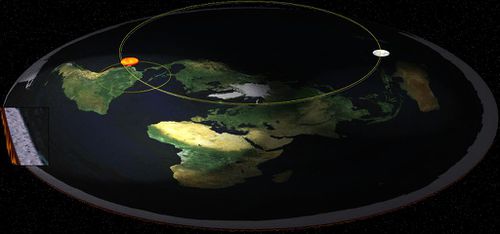Difference between revisions of "Sun"
From The Flat Earth Wiki
PeteSvarrior (talk | contribs) |
PeteSvarrior (talk | contribs) |
||
| Line 5: | Line 5: | ||
==Spotlight effect== | ==Spotlight effect== | ||
| − | The Sun's area of light is limited to | + | The Sun's area of light is limited to an elliptic area of light upon the earth much like the light of a lighthouse is limited to a finite area around it. The rotating light on a lighthouse does not propagate infinitely into the distance. This means that only certain portions of the Earth are lightened at a time. It also describes how night and day arise on a Flat Earth. The apparent view of rising and setting are caused by perspective, just as a flock of birds overhead will descend into the horizon as they fly into the distance. |
===Rendered picture of the Sun in relation to the Earth=== | ===Rendered picture of the Sun in relation to the Earth=== | ||
Revision as of 19:22, 9 December 2017
The sun is a rotating sphere. It has a diameter of 32 miles and is located approximately 3000 miles above the surface of the earth.
Spotlight effect
The Sun's area of light is limited to an elliptic area of light upon the earth much like the light of a lighthouse is limited to a finite area around it. The rotating light on a lighthouse does not propagate infinitely into the distance. This means that only certain portions of the Earth are lightened at a time. It also describes how night and day arise on a Flat Earth. The apparent view of rising and setting are caused by perspective, just as a flock of birds overhead will descend into the horizon as they fly into the distance.
Rendered picture of the Sun in relation to the Earth
More:
- Temperature Variations of sunlight
- Distance to the Sun
- The Seasons
- The Setting of the Sun
- Constant Speed of the Sun
- Magnification of the Sun at Sunset, or how the sun maintains its size throughout the day.


